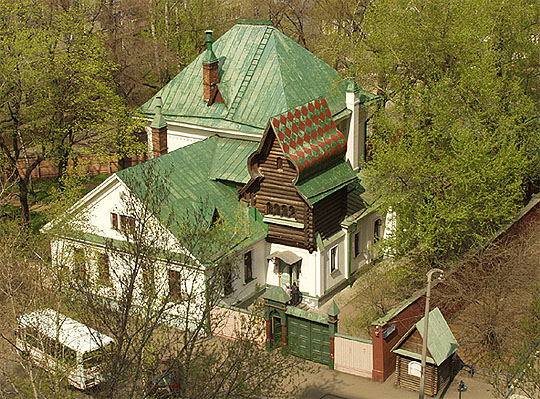

Location: Pereulok Vasnetsova 13 Map
Tel. (495) 281 1329
Subway: Sukharevskaya, Prospekt Mira
Open: 10am- 5pm Wed- Sun
Vasnetsov House Museum is located in the outskirts of Moscow at the address of Pereulok Vasnetsova 13. Vasnetsov House Museum is a former residence of a famous Russian painter whose paintings often involved depiction of Medieval Russian and Old Russian stories and folklore. In fact some of the features of the medieval architecture are visible in the construction of the house.
The house at 13 Vasnetsov Lane was
designed by Viktor Vasnetsov and architect Mikhail Priyomyshev. In
1891, the artist purchased land in Troitskaya Sloboda from the
peasant family of the Filippovs and began creating sketches for the
external and internal arrangement of the mansion. The construction
was carried out by the peasants of the Vladimir province and was
completed by 1894. Viktor Vasnetsov lived here until his death in
1926.
The wooden mansion was built in the neo-Russian style,
combining elements of ancient Russian architecture and modernity. A
characteristic feature of Vasnetsov's house is the combination of
architectural forms from different centuries: the living room was
planned in the boyar style of the 17th century, while the dining
room was designed as a peasant's dwelling. Traces of northern
architecture are also visible in the composition of the house.
The living quarters on the ground floor are built of massive
plaster logs. The porch is decorated with tiles, columns "melons"
and reliefs. There is a tiled frieze under the cornice. The
staircase to the office leads through a log house with a
barrel-shaped covering, reminiscent of temples in the North of
Russia.
The first floor was residential: the living room,
dining room and living rooms of Vasnetsov's wife and children were
located here. The second floor was intended for a workshop, the size
of which is 110 meters and the height is six.
The windows are
decorated with stucco columns and platbands in the form of
kokoshniks. Materials for home improvement were created in the
Abramtsev and Stroganov workshops. The facade is decorated with
tiles from the Savva Mamontov ceramic factory. The back rooms are
made in the form of Old Russian huts.
From 1978 to 1980,
general restoration of the house and nearby buildings was carried
out. In the course of the work, the appearance of the premises,
cobblestone pavements and brick paths in the courtyard were
restored.
After Vasnetsov's death
in 1926, members of his family turned to the board of the Tretyakov
Gallery with a request to arrange a permanent exhibition in the
house. Painters Mikhail Nesterov and Pavel Korin also took part in
organizing the exposition. The exhibition opened in 1927 and
consisted of 212 exhibits: paintings, household items and graphics
of the artist.
“Our house was empty - as if the soul had
flown out of it - everything here was his, bore his imprint - it’s
scary to touch something, to change something. Our common decision
is to keep everything as it was - to arrange something like a
house-museum ...
Alexey Vasnetsov "
According to the
philologist Konstantin Bogdanov, the opening of the house-museum
became possible due to the approval of Vasnetsov's artistic style by
the Soviet authorities. In the Great Soviet Encyclopedia for 1948,
Vasnetsov was called the forerunner of socialist realism. The theme
of folklore, popular in the artist's work, was also used by
propaganda to strengthen the national spirit.
In 1948, an
exhibition event dedicated to the centenary of the birth of Viktor
Vasnetsov was opened. In 1950, the Council of Ministers of the USSR
issued a decree on the organization of a museum in the house. The
painter's relatives donated the premises, property and art
collection to the state museum.
Since 1986 the museum has
been part of the State Tretyakov Gallery.
By
the opening of the museum in 1953, the atmosphere of the house was
completely restored. The museum's exposition includes more than 25
thousand exhibits: paintings, household items, collections of
photographs and early studies. All items shown are genuine.
The art workshop on the second floor contains tools and
architectural sketches in the neo-Russian style. In this room the
paintings "Tsar Ivan Vasilyevich the Terrible" (1897) and "Heroes"
(1881-1898) were painted. The painting "Baba Yaga" hangs on the
wall. In total, the house-museum contains a number of paintings by
the artist: "Nestor the Chronicler", "Varangians", "Bogatyrsky
Skok", "Fight of Dobrynya Nikitich with the seven-headed snake
Gorynych", "Princess Frog", "Portrait of M. V. Nesterov", "Archangel
Michael defeats the devil", "Flying carpet", "Princess Nesmeyana",
"Sivka-Burka", "Kashchei the immortal", "Sleeping princess".
The living room is furnished with furniture of the 19th and 20th
centuries and tiled stoves, some of which were made by the artist's
brother, Arkady Vasnetsov. Artistic meetings were held in this room,
which were attended by cultural figures: Ilya Repin, Valentin Serov,
Vasily Polenov, Vasily Surikov, Fyodor Chaliapin.
Since 2016, all branches of the
Tretyakov Gallery have been implementing a project to reorganize the
museum space. According to the plan for the development of the
Vasnetsov house-museum, by 2019 a center for decorative creativity
will appear on its basis. The main goal of the changes being made is
an equal distribution of museum activities among all centers of the
Tretyakov Gallery.
In addition to the permanent exhibition,
the Vasnetsov House Museum organizes temporary projects. In 2016,
the exhibition “V. M. Vasnetsov's Family. Life and Being ”, which
featured documentary materials, photographs and sketches of the
artist's family.
In 2017, 29 landscape sketches by the artist
were exhibited, painted in the vicinity of Abramtsevo, Moscow,
Vyatka and Akhtyrka. The organizers of the event tried to emphasize
the importance of landscape as a separate direction in Vasnetsov's
work.